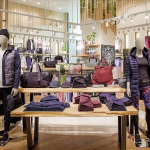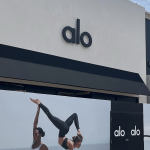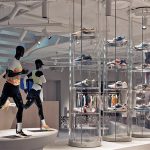The shift in the Easter calendar stymied the robust retail sales growth of the last few months, pushing a week of holiday sales into the March period. Some were also pointing to colder weather in the Northeast as a reason for a retail sales gain that would have been seen as great if not for the heat the market has produced since January.
The International Council of Shopping Centers-UBS survey of 72 retailers resulted in a 4.4% increase for the month of April, below his 5.0% estimate. “It was winter-like weather in the Northeast,'' said Michael P. Niemira, chief economist at the ICSC. He said there were also other factors in play.
Higher prices for gasoline and food were also cited for the numbers.
“I feel (the price hikes) are already hitting the low-end customer,'' said Ken Perkins, research analyst at Thomson First Call in a published report. He pointed to the fact that eight of 10 discounters missed sales expectations in April.
What the analysts are missing is that retail sales continue to grow despite the war, higher gas prices and a still-murky-but-improving job picture.
After all, even with the Easter shift taken into account, we only saw 10 of the 42 retailers we track report negative comps for the month. Niemira estimated the shift cost retailers about 1.5 percentage points in comp sales. That fact alone would have put three of those 10 retailers into positive territory.
The average comp sales gain for the January through March period was 6.7%.
Foot Locker, Inc. didnt light up the market with its first quarter same-store sales report. The report indicated that Europe, which along with the DotCom business had been driving much of the Foot Locker gains in the last year, had become a drag on the total numbers. Consolidated comparable store sales inched up just 0.3% in a quarter that produced high-single- to double-digit gains for most retailers.
Comps in the International business were down “low-single digits” according to a company release on Thursday. Senior company officials told SEW that the International business was down in low- to mid-single digits “throughout the quarter”. Conversely, FL said the U.S. business picked up later in the quarter, with February up “low singles”, March down in “low singles”, and April posting a low- to mid-single-digit comp sales gain in the U.S.
Foot Locker told SEW that the “Foot” group, which includes the Foot Locker, Lady Footlocker, and Kids Footlocker chains, was up in “low singles” for the quarter. Champs and the DotCom business, which includes the Internet and Eastbay businesses, were “flat” in Q1.
According to the company, the business weighted heavier toward the Classics end of the spectrum in Q1, which they said pushed average retail selling prices lower. Foot Locker treasurer Peter Brown said that the ASP decline is expected to “stabilize toward the end of Q2 and should improve in third quarter as the company receives more Nike marquee product.
Total sales for the period increased 5.1% to $1.19 billion, compared to $1.13 billion in the year-ago period. Excluding the benefits of the weaker U.S. dollar, sales for Q1 rose 2.0%.
Foot Locker chairman and CEO Matt Serra reiterated earnings guidance of growth in the 10% to 20% range, which would put them in the range of 30 cents to 32 cents per share. Analysts on average were expected between 32 cents and 33 cents. The soft sales results and the prospect of a weakening Europe was credited with pushing FL shares down 6.5% last week to close at $22.45 on Friday.
>>> What happened to the shift to performance in the market? And why would Foot Locker cut back on K-Swiss if Classics are so hot? Has the planned shift to performance — which we hear from many retailers — not materialized???
Famous Footwear saw April soften a bit from its strong March, due primarily to the one week shift in Easter. Comps for April dipped 1.2% for the month. Same-store sales for the combined March-April period were still up 4.2% and are up 2.6% for the three month YTD period. Total sales were flat at $91.9 million.
The family footwear retailer said that had gains in athletic footwear, dress shoes, and sandals.
The YTD sales comp gain and an improving gross margin picture prompted parent Brown Shoe Company to raise its Q1 and full year earnings guidance. BWS now sees diluted EPS in the 43 cents to 45 cents per share range for Q1, up from previous estimates in the range of 30 cents to 35 cents.
The increase would still see them fall short of the 49 cents per share delivered in Q1 last year, but the Q1 2004 guidance includes approximately 10 cents a share for “assimilation and transition of the Bass footwear license” acquired at the beginning of the fiscal quarter.
Full year earning are now estimated in the range of $3.20 to $3.25, compared to previous guidance of $3.15 and diluted earnings per share of $2.52 in fiscal 2003.
Sales are forecast at roughly $2.0 billion, versus fiscal 2003 net sales of $1.8 billion.
Shoe Carnival posted another negative comp sales month in April, reporting a 4.6% decrease in same-store sales after a 4.9% decline in March and a 5.0% gain in the year-ago April. First quarter comps are now in negative territory, down 2.2% for the period.
Shoe Carnivals shift in pricing strategy away from all-store BOGOs is now having an affect on the athletic business, which had continued to post positive results despite issues in other categories. Mens and Womens Athletics were down in mid-single digits in April, but Childrens Athletic posted a low-single-digit gain.
Total Footwear category comps were down 4.9%, but Accessories were up in low-single digits. Management said they saw a “significant acceleration” of sandal sales for all genders in the month. Mens boots were also said to be a bright spot.
SCVL still feels the reduction in BOGO promotional events is the best long-term strategy for the chain. They are managing to keep inventories in line as they make the shift, reporting that inventory at quarter-end were down “about one percent” versus Q1 last year when measured on a per store basis.
Shoe Carnival now expects to come in at the “upper end” of its earnings guidance for Q1, which was forecast at 31 cents to 35 cents per diluted share.
DSW Shoe Warehouse continued its positive momentum in comp store sales results, posting a 5.3% same-store sales gain for April versus a 3.2% decline in April last year. The increase comes on the heels of two solid months of double-digit gains in comps, netting a 10.6% same-store sales increase for the first quarter.
Pacific Sunwear posted a double-digit comp sales gain on top of prior year double-digit increase for the sixth month out of the last seven months, thanks mostly to its surf/skate-inspired PacSun chain. The d.e.m.o. chain saw its positive trend slow considerably, hurt in April by a low-single-digit decline in the Mens business.
The PacSun stores posted a 12.4% comp sales increase for April on top of a 16.0% gain in April last year. The Guys business was up 8.0% and Girls was up 6.0% for the month. Footwear again posted gain of more than 20% and Accessories were up in the “mid-teens”.
At d.e.m.o., a low-single-digit gain on the Girls end of the business and a low double-digit gain in Accessories, more than offset the Mens decline. The hip-hop chain repored a 2.9% comp sales gain for the month on top of a 24.9% increase in April 2003.
The prize for the most robust comp store sales gain for the first quarter goes to Urban Outfitters, which posted a whopping 32.0% increase in same-store sales versus the year-ago period. Total sales jumped 59.2% versus last year. The company saw a 95% jump in direct-to-consumer sales and a 47% rise in wholesale sales for the period.
The Urban Outfitters nameplate posted a 33% comp increase, while Anthropologie increased 32% and Free People increased 54% for the quarter.
The Buckle put together a solid sales quarter as comps rose 11.6% for the three-month period. April delivered an 8.6% same-store sales increase on top of a 1.2% gain in April last year.
Niemira believes that if stores maintain a 4.4% pace for the rest of 2004, the retail market could end up having the best full-year performance since a 6.7% gain in 1999. He is forecasting that May comps will increase 4.5%, driven by Mother's Day and the start of summer with Memorial Day weekend.
And Retail Execs Like What They See
Despite the “modest” sales results for April, retail executives appear to remain pretty positive about the business. According to the NRF Executive Opinion Survey, a monthly index by the National Retail Federation, retail executives were more optimistic in April, citing an increase in sales and traffic along with increased control over pricing.
The Retail Sector Performance Index (RSPI) remained strong in April with a reading of 58.2 points, up 10.5 points from a year ago and virtually unchanged from Marchs 58.3 point reading. The Index, or RSPI measures retail executives evaluations of a number of core retail performance metrics and is based on a scale of 0.0% to 100.0, with 50.0 equaling normal.
The RSPI was once again fueled by above-normal readings in all key aspects of the survey, with one notable change. Pricing power, which has read below normal since the surveys inception, reached a new high for April. The Pricing Index jumped more than 20 points to 58.8, demonstrating that retailers are becoming less dependent on markdowns to move merchandise.
“Now that retailers have more control over pricing, they are in the drivers seat,” said Tracy Mullin, NRF President and CEO.













